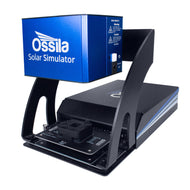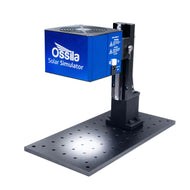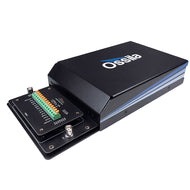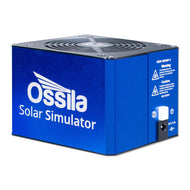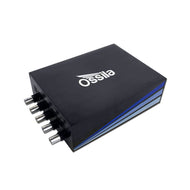Photovoltaic Testing
Reliable, trustworthy photovoltaic testing underpins any solar cell laboratory. Accurate characterization of solar cells relies on two components:
- A calibrated light source for standardized illumination (a Solar Simulator or Indoor Light Simulator)
- Reliable electrical characterization equipment for current-voltage (I-V) testing. This may consist of several components (source measure unit, test boards, probe station, etc.) or an enclosed measurement system like the Ossila I-V Test System.
To characterize photovoltaic performance traditionally requires taking a I-V (or J-V curve) under AM 1.5G illumination. This measurement will give you the key metrics needed to find device efficiency (VOC, JSC, FF, PCE). For experimental photovoltaic materials, you may also want to measure device stability through measurement such as current stabilization or maximum power point tracking.
PV Testing Equipment | Substrates and Fabrication | Light Simulator Classifications | Resources and Support
Filter by product:
Automatic Pixel Switching for Faster Measurements
When you fabricate solar cells, you may create several individual cells on a single substrate. At Ossila, we call these individual cells pixels, and we refer to the full substrate as a device. For example, if you use our 25 mm square multi-electrode deposition mask (E2001A1) with a 25 mm ITO glass substrate (S2006C1), you will produce four separate solar cells on a single substrate. This gives you a device with four pixels.
Available in the Automated Solar Cell Testing Kit and automated Solar Cell I-V Test System, automatic pixel switching connects to each pixel on your device, without manual reconfiguration, to speed up your measurements and enable lifetime metric tracking for multiple pixels.
Substrates and Fabrication
Classification of Ossila Light Simulators
Designed for small areas, the output is AAA rated over a 15mm diameter illuminance area and adheres to the latest solar simulator standards (IEC 60904-9:2020). By default, the solar simulator outputs 1 sun of illuminance (100 mW/cm2) over the wavelength range of 350 nm – 1000 nm but you can adjust the optical output power down to an illuminance of 10 mW/cm2 if needed. You can also individually control the output power of each of the 11 LED wavelengths.
With our indoor light filter, you can also mimic indoor spectra according to recent IEC TS 62607-7-2:2023 international standards for testing indoor solar cells.
| LED Solar Simulator | Indoor Light Simulator | |
|---|---|---|
| Spectral match | A | A |
| Spatial uniformity over 15 mm diameter area | A | B |
| Spatial uniformity over 25 mm diameter area | B | C |
| Spatial uniformity over 32 mm diameter area | C | N/A |
| Temporal instability | A | SA |
View full solar simulator range
Resources and Support
Buying Guides
 Solar Simulator Light Sources
Solar Simulator Light Sources
Choosing the right light source for your solar simulator is one the most important decisions to make when setting up a PV testing laboratory.
Read more...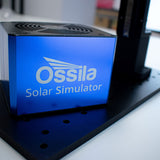 Why You Should Buy the Ossila Solar Simulator
Why You Should Buy the Ossila Solar Simulator
A solar simulator is an essential piece of equipment for any lab working with photovoltaics, optoelectronics, or any research that requires a simulated sunlight environment.
Read more...Testing
 Solar Cell Testing & Characterization
Solar Cell Testing & Characterization
One main application of a solar simulator is to test solar cell devices and modules. To characterize how solar cells will perform in the real world, it is vital that you use a solar source that mimics the suns spectrum well. You could of course use actual sunlight, but this is an uncontrollable variable.
Read more... Solar Cell J-V Curve: How to Measure the IV Curve of a Solar Cell
Solar Cell J-V Curve: How to Measure the IV Curve of a Solar Cell
When it comes to testing the performance of solar cells, accurate measurements and reliable equipment are essential. The fundamental way to test your solar cell performance is by taking a current-voltage (I-V or J-V) measurement. The I-V curve provides valuable insights into a solar cell's efficiency, power output, and more generally electrical characteristics within the device.
Read more... Analyzing and Improving Low Device Metrics: FF, VOC and JSC
Analyzing and Improving Low Device Metrics: FF, VOC and JSC
Anaylzing key device metrics such as fill factor (FF), open-circuit voltage (VOC), and power conversion efficiency (PCE), can help you find potential issues with your solar cell devices
Read more...Source measure units are vital pieces of equipment used for many applications, including the measurement of new solar cells. A small-scale test device is usually used to characterize the solar cell efficiency.
Read more... SMU Measurements: The Basics, I-V Curves, and Voltage Tracking
SMU Measurements: The Basics, I-V Curves, and Voltage Tracking
Learn how to conduct various SMU measurements such as solar cell I-V curves, external voltage tracking, and basic quick measurements.
Read more...Use the following Python code to plot this data using Panda DataFrames. Just copy and paste the code below into your Python virtual environment and start plotting.
Read more...The aim of this article is to contextualise the spectral irradiance graphs you see throughout our website and elsewhere.
Read more... Interpreting J-V Curves: Insights into Solar Cell Performance
Interpreting J-V Curves: Insights into Solar Cell Performance
With so many variables in a PV device, it can be difficult to pinpoint the exact issue affecting your solar cell's performance.
Read more... Solar Cells: A Guide to Theory and Measurement
Solar Cells: A Guide to Theory and Measurement
A solar cell is a device that converts light into electricity via the photovoltaic effect.
Read more...Maintenance and Operation
 Automated Solar Simulator Assembly
Automated Solar Simulator Assembly
This system was designed to be easy to use, and effortless to assemble. This video and subsequent guide will demonstrate how easy setting up your testing lab can be with the Ossila Automated Solar Cell Testing Kit.
Read more... Measuring J-V Curves with Ossila Solar Cell Testing Equipment
Measuring J-V Curves with Ossila Solar Cell Testing Equipment
When it comes to testing the performance of solar cells, accurate measurements and reliable equipment are essential. If you are conducting research into PV materials, understanding how to measure and interpret J-V curves is crucial in assessing device performance
Read more... How to Set Up a Solar Simulator Light Source
How to Set Up a Solar Simulator Light Source
The solar simulator light source is compact, lightweight and can be easily installed in any lab using adjustable height stand provided with it.
Read more... How to Check Solar Simulator Calibration
How to Check Solar Simulator Calibration
It is important to ensure that your solar simulator is outputting a consistent spectral output. Different solar simulators will have different bulb lifetimes.
Read more...